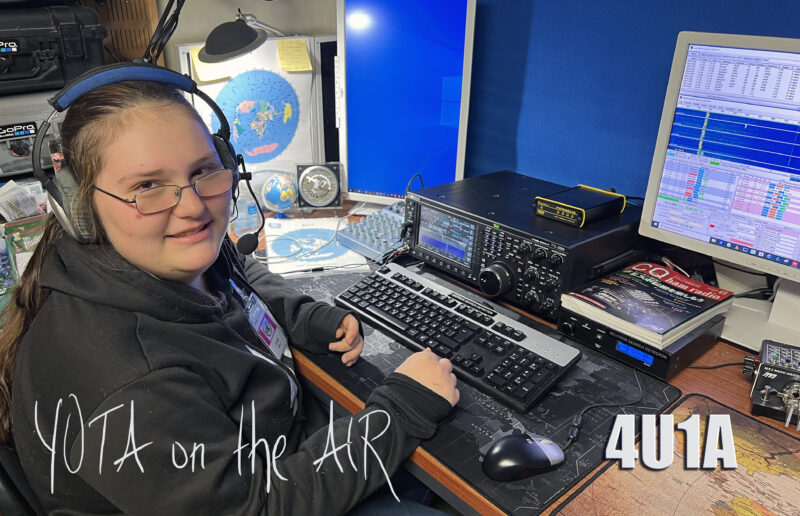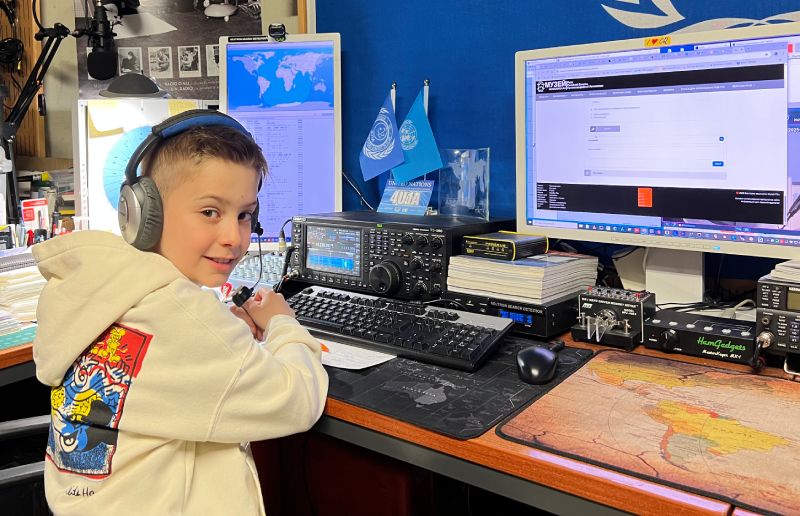Now simply called “CW”, radio communication by Morse code was the only way to communicate for the first decade or more of Amateur Radio. Radiotelegraphy, the proper name, descends from landline (wired) telegraphy of the 19th century, and retains some of the old culture, including a rich set of abbreviations and procedures. Morse sent by spark gap transmitter was the first wireless communication mode. These “damped waves” were very broad and inefficient for communication. They were soon replaced by “Continuous Wave” (CW) transmission, using vacuum tube oscillators that were capable of a very pure note. Today, modern Amateur Radio transceivers use solid state components and microprocessors to support a variety of communication modes including CW, voice, image and many digital data modes.
- All About the Telegraph and Deciphering Morse Code Text (by Ms. Corrine Kimball)
For the beginner:
1. Want to communicate with fellow hams around the world using even a modest rig and antenna?
2. Want to stay in touch when on vacation to some remote area where you don’t have access to a repeater or cell phone service?
3. Want to meet a whole new community of amateurs that share a common bond?
4. Want to expand your operating capabilities with little or no cost?
If you answer “Yes” to any of the questions, then becoming skilled in CW is the answer.
CWops CW University advisors are ready and willing to teach you a new skill that will open a world of fun and opportunities.
We organize the learning Morse Code courses. These courses are organized for local staff, as well as for the children of local staff. You must fill in the form (below) and we will send more information to your E-mail address.
On May 13, 2005, Chip Margeili (K7JA) and Ken Miller (K6CTW) made an appearance onThe Tonight Show with Jay Leno on NBC, competing with (and defeating) the U.S. champion cell-phone text messenger in a message-completion speed contest. Very cool contest.
Video by NBC
The ARRL and ARCDXC recommends:
Learn Morse Code Yourself:
CW OPS – Learning Morse Code in an On-Line Class Session (Part 1)
ARRL CW Training CDs
CW-related training CDs available through the ARRL online store.
Morse Code Online Reference
Listen to each character and its Morse code sound.
W1AW Code Practice Audio Files
Archive mp3 files of W1AW code practice runs at speeds 5wpm-40wpm.
W1AW Code Practice Schedule
Times, frequencies, and speeds.
CWops CW Academy
The CWops club offers group code lessons online and tutors on-air.
G4FONs Morse Training Program
This free application uses the Koch method to teach CW. Letters are sent at the speed which you hope to achieve, but only two at a time. When you reach 90% proficiency with two letters, two more letters are added.
The Ham Whisperer’s Morse Code Course
Eleven lessons to learn the International Morse Code. This course is designed to help you learn the Morse Code from the easiest to the hardest characters. It covers all 26 letters of the English alphabet, numbers 0 to 9, some punctuation marks, as well as some procedural signals.
K9OX’s Multi-Platform Morse Training Program
A free CW application for Windows, Mac, Linux, or DOS; sends semi-random letters and numbers at variable speeds.
Learn CW Online
You can learn and practice CW at various speeds and formats with words, letter groups, and call signs through the Koch method. Offers training for the unique QTC exchange used in the Worked All Europe contest.
AA9PW’s CW Practice
You can practice CW at various speeds and formats or download .mp3 files.
RufzXP Training Software
Software designed for those who want to increase to ultra high speed levels; sends random calls that can top 200 words per minute!
Software designed to make it easy to learn Morse code, as well as improve the skills of those who already know the code.The basic methods used to achieve this are Koch’s method and Farnsworth timing.
A program to decode morse code (CW) via sound card to text. It can work as a narrow-band sound DSP-filter also. All you need is a receiver and computer with a sound card. A 30-Day Trial is available.]
This 12-lesson course is designed for beginners who don’t know the difference between a dit and a dah. It teaches students to copy and write down letters, rather than copying in their heads. It starts with identifying the sound of dits and dahs and progresses to a five word per minute speed.
There is no cost or obligation to participate in CWops CW Academy Classes and membership is not required. Enrollment is open to anyone with the desire to learn or improve their proficiency in Morse Code.
Learn Morse Code via Internet Streaming
Joe Cotton, W3TTT announces the beginning of a new internet streaming radio station. Practice listening to Morse code translation of Internet news stories.
Online Morse Code keyer
This page emulates a Morse keyer combined with an iambic paddle.
Learn Morse Code
Morse code is a method of communication that uses short tones (dits) and long tones (dahs) in various sequences to make letters, numbers, and special characters. This tool will help beginners learn Morse code.
LCWO
Learn CW ONLINE
Brief history of the radio:
- WiKipedia
- Business Studies: Broadcasting and Its History
- Pioneers of Radio
- History and facts (Britannica)
- Radio Engineering
- Radio Broadcasting, History
 |
 |
Some feedback from around the Globe:
| From: Mr. Chloe Pedersen USA
|
From: Mrs. Erin Kimball
|
